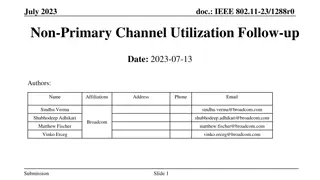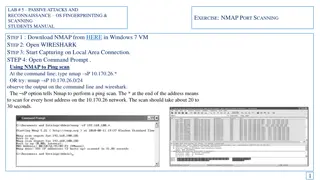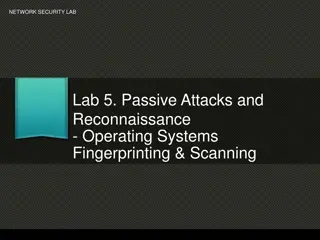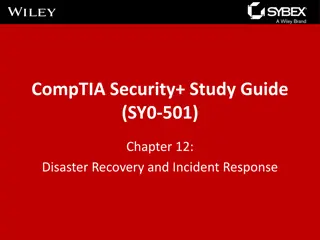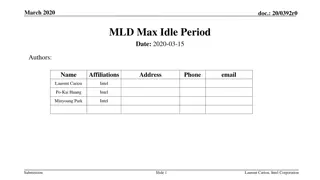
Advanced Idle Scanning Techniques for Network Security
Explore advanced idle scanning techniques, including port scanning, revealing trust relationships, and more. Learn about TCP/IP networks, OSI 7-layer model, encapsulation, IP and TCP header formats, ping sweeps, and traceroute methods for network analysis and security assessment.
Download Presentation

Please find below an Image/Link to download the presentation.
The content on the website is provided AS IS for your information and personal use only. It may not be sold, licensed, or shared on other websites without obtaining consent from the author. If you encounter any issues during the download, it is possible that the publisher has removed the file from their server.
You are allowed to download the files provided on this website for personal or commercial use, subject to the condition that they are used lawfully. All files are the property of their respective owners.
The content on the website is provided AS IS for your information and personal use only. It may not be sold, licensed, or shared on other websites without obtaining consent from the author.
E N D
Presentation Transcript
ADVANCED IDLE SCANNING by Demetris Papapetrou
Contents Introduction to TCP/IP Networks Port Scanning Techniques Idle Scanning Advanced Idle Scanning Revealing Trust Relationships Page 2
The Basics INTRODUCTION TO TCP/IP NETWORKS Page 3
OSI 7 Layer Model L7 L6 L5 L4 L3 L2 L1 Application HTTP, FTP, SMTP Presentation MIME, MPEG Session RPC, NETBIOS Transport TCP, UDP ICMP Network IP ARP Data Link Ethernet Physical Page 4
Encapsulation Page 5
IP Header IP Header Format Page 6
TCP Header TCP Header Format Page 7
Ping Sweep It is a technique to detect live hosts Pings are not 100% reliable On LANs we can use ARP pings They use ICMP Echo Requests and Echo Replies They can be blocked by firewalls very easily Page 8
Ping Sweep Host is down or Pings are blocked by a Firewall Host is up and replies to Pings Server Server Client Client Attempt times-out Page 9
Traceroute It is a technique to trace the network nodes/hops that our packets traverse until they reach their destination A clever replacement of IP Record Route We usually send ICMP or UDP packets Hackers use TCP as well And receive ICMP Time Exceeded in Transit messages They are used by hackers to map the target network To block them drop outbound ICMP Time Exceeded Page 10
Traceroute Attacker Router Router Target Ping Request TTL=1 Step 1 ICMP TimeX Ping Request TTL=2 Step 2 ICMP TimeX Ping Request TTL=3 Step 3 Ping Reply Page 11
Sample Traceroute Output Page 12
The Basics PORT SCANNING TECHNIQUES Page 13
TCP Port Scanning It is a technique to detect which TCP enabled services are running/listening on the target host Based on the Three-Way-Handshake and TCP Flags SYN, FIN, URG, PSH, RST, ACK A port can be: Open Closed Filtered Page 14
TCP Connect Scan Open Port Client Server Port is OPEN OK. Let s connect Page 15
TCP Connect Scan Closed Port Client Server Port is CLOSED OK, I get it. No Service Page 16
TCP Connect Scan Filtered Port Client Server Port is FILTERED Port is FILTERED Port is FILTERED Connection times-out Page 17
TCP SYN Scan Open Port Client Server Port is OPEN Terminate Connection Page 18
TCP FIN Scan CLOSED OPEN | FILTERED Server Server Client Client Port is OPEN | FILTERED Port is CLOSED Attempt times-out Page 19
TCP XMAS Scan CLOSED OPEN | FILTERED Server Server Client Client Port is OPEN | FILTERED Port is CLOSED Attempt times-out Page 20
TCP ACK Scan UNFILTERED Stateless Inspection or No Firewall FILTERED Stateful Inspection Server Server Client Client Port is FILTERED Port is OPEN | CLOSED Attempt times-out Page 21
UDP Port Scanning It is a technique to detect which UDP enabled services are running/listening on the target host UDP is a connectionless protocol, hence there is no Three-Way-Handshake and no flags The protocol is not responsible to indicate whether a connection has been established. This is the job of upper layer protocols Therefore we don t detect open ports but closed ones We can also use application protocols to find open ports Page 22
UDP Scan Regular CLOSED OPEN | FILTERED Server Server Client Client Port is OPEN | FILTERED Port is CLOSED Attempt times-out Page 23
UDP Scan Protocol Specific OPEN FILTERED Server Server Client Client Port 161 FILTERED Port 161 OPEN Attempt times-out Page 24
More Advanced Stuff IDLE SCANNING Page 25
What is it? The most stealthy scan technique so far The attacker never sends traffic to the target using his/her real IP address, but instead.. Instructs a victim machine (zombie) to do it for him/her If a security administrator or an IPS takes action against the attacker , it is the poor zombie who will take the blame (blacklisted or reported to the authorities) The scan traverses the target s firewall based on the rules that apply for the zombie host (not the attacker s host) Page 26
Prerequisites In order for the scan to work properly: The zombie must generate incremental IP IDs globally (not per session/host) The zombie must accept TCP SYN/ACK packets (no stateful filtering for incoming packets) The zombie must be idle (no traffic generated) The attacker must be able to spoof his IP address (no NATing) The attacker must be able to send TCP SYN/ACK packets (no stateful filtering on his end, for outgoing packets) Page 27
IP Header IP Header Format Page 28
TCP Behavior Packet that immediately terminates a connection Unexpected packet that doesn t belong to any session Unexpected packet with no associated SYN Client Server Client Server Client Server Page 29
TCP Behavior The basic TCP rule illustrated above is: Most TCP packets (e.g. SYN, FIN, ACK, SYN/ACK, etc) cause the receiving host to send a reply back to the sender (e.g. SYN/ACK, FIN/ACK, RST, etc) RST packets don t cause a reply to be generated Page 30
TCP Idle Scan Open Port Target SYN/ACK Zombie Attacker RST IPID=1 RST IPID= 3 * IPID increments by 2 on newer OSes Page 31
TCP Idle Scan Closed Port Target SYN/ACK Zombie Attacker RST IPID=1 RST IPID= 2 Page 32
TCP Idle Scan Filtered Port Target (no response ) SYN/ACK Zombie Attacker RST IPID=1 RST IPID= 2 Page 33
Possible Issues Certain things can render regular Idle Scans ineffective or hard to perform: Some Operating Systems randomize or set the IP ID to zero until a connection has been established (completion of 3-Way- Handshake) Busy/talkative zombie hosts Stateful firewalls placed near or installed on zombie hosts The Internet is moving from IPv4 to IPv6 Page 34
Even More Advanced Stuff ADVANCED IDLE SCANNING Page 35
Research Backgound Not a new scanning technique but an enhancement of the existing Idle scan Some of the ideas implemented have been previously suggested by people on the Bugtraq mailing list but no research work was ever published or tools created (besides hping) Our research work was performed in 2009 - 2010, hence the listed examples are old but still applicable to newer Operating Systems Page 36
Overcoming Obstacle 1 Obstacle Some Operating Systems randomize or set the IP ID to zero until a connection has been established (completion of 3-Way- Handshake) Observation Popular tools send SYN/ACK packets to zombies. This is a clever trick which serves two purposes: - to check for incremental IP IDs - to check if there is a stateful firewall protecting the zombie Page 37
Overcoming Obstacle 1 Solution 1 Why only use SYN/ACK packets? We should test different TCP Flags and check if any of them cause the zombie machine to reply with incremental IP IDs Solution 2 Since the IP ID field is part of the IP and not the TCP header, we can use other Layer 4 protocols (TCP, UDP, ICMP, etc) to check for incremental IP IDs Page 38
IP IDentifier Tool Usage: identifier.py [options] target Options: -h, --help -T TCP -U -I ICMP use ICMP scan mode P=Ping (default) T=Timestamp A=Address Mask -P use IP Protocol scan mode -t TCP_PORT TCP port to use for scanning -u UDP_PORT UDP port to use for scanning -p IP_PROTO IP protocol number to use for scanning --ttl=TTL how many hops the packet will traverse --tracert detect IPID for every hop in the path --max_hops=MAX_HOPS terminate traceroute at hop N. (use with tracert only) --max_noresp=MAX_NORESP terminate traceroute after N irresponsive hops. (use with --tracert only) -c PACKET_COUNT number of packets to send show this help message and exit use TCP scan mode with one or more of the following flags S=Syn, A=Ack, F=Fin, X=Xmas, N=Null use UDP scan mode Page 39
Open Port 23/tcp # ./identifier.py -TSAFXN -t23 -c3 172.16.1.17 Scan process initiated... TCP SYN: ip=172.16.1.17 id=9899 inc=0 TCP SYN: ip=172.16.1.17 id=59880 inc=49981 TCP SYN: ip=172.16.1.17 id=64964 inc=5084 ---------------------------------------------------------------------- TCP SYN/ACK: No Response TCP SYN/ACK: No Response TCP SYN/ACK: No Response ---------------------------------------------------------------------- TCP ACK: ip=172.16.1.17 id=37149 inc=0 TCP ACK: ip=172.16.1.17 id=40149 inc=3000 TCP ACK: ip=172.16.1.17 id=50986 inc=10837 ---------------------------------------------------------------------- TCP FIN: No Response ---------------------------------------------------------------------- TCP XMAS: No Response ---------------------------------------------------------------------- TCP NULL: No Response ---------------------------------------------------------------------- Page 40
Closed Port 80/tcp #./identifier.py -TSAFXN t80 -c3 172.16.1.17 Scan process initiated... TCP SYN: ip=172.16.1.17 id=38072 inc=0 TCP SYN: ip=172.16.1.17 id=38073 inc=1 TCP SYN: ip=172.16.1.17 id=38074 inc=1 ---------------------------------------------------------------------- TCP SYN/ACK: ip=172.16.1.17 id=38075 inc=0 TCP SYN/ACK: ip=172.16.1.17 id=38076 inc=1 TCP SYN/ACK: ip=172.16.1.17 id=38079 inc=3 ---------------------------------------------------------------------- TCP ACK: ip=172.16.1.17 id=38080 inc=0 TCP ACK: ip=172.16.1.17 id=38082 inc=2 TCP ACK: ip=172.16.1.17 id=38084 inc=2 ---------------------------------------------------------------------- TCP FIN: No Response ---------------------------------------------------------------------- TCP XMAS: No Response ---------------------------------------------------------------------- TCP NULL: No Response ---------------------------------------------------------------------- Page 41
Open Port 137/udp # unicornscan -mU 192.168.10.9 UDP open netbios-ns[ 137] from 192.168.10.9 ttl 128 # ./identifier.py -U u137 c5 192.168.10.9 Scan process initiated... UDP Scan: No Response UDP Scan: No Response UDP Scan: No Response UDP Scan: No Response UDP Scan: No Response ---------------------------------------------------------------------- Page 42
Open Port 137/udp (w/ payload) # hping2 192.168.10.9 --udp -p 137 -c 5 -r -d 50 --file ../137.txt HPING 192.168.10.9 (eth0 192.168.10.9): udp mode set, 28 headers + 50 data bytes [main] memlockall(): Success Warning: can't disable memory paging! len=293 ip=192.168.10.9 ttl=128 id=925 seq=0 rtt=0.4 ms len=293 ip=192.168.10.9 ttl=128 id=+1 seq=1 rtt=0.3 ms len=293 ip=192.168.10.9 ttl=128 id=+1 seq=2 rtt=0.4 ms len=293 ip=192.168.10.9 ttl=128 id=+1 seq=3 rtt=0.4 ms len=293 ip=192.168.10.9 ttl=128 id=+1 seq=4 rtt=0.4 ms 12:20:19.933615 IP (tos 0x0, ttl 128, id 58360, offset 0, flags [none], proto UDP (17), length 78) 192.168.10.3 192.168.10.3.4115 4115 > 192.168.10.9. 192.168.10.9.137 137: NBT NBT UDP PACKET(137): QUERY; REQUEST; BROADCAST 12:20:19.934388 IP (tos 0x0, ttl 128, id 925 id 925, offset 0, flags [DF], proto UDP (17), length 185) 192.168.10.9. 192.168.10.9.137 137 > 192.168.10.3 192.168.10.3.4115 4115: NBT NBT UDP PACKET(137): QUERY; POSITIVE; RESPONSE; 12:20:22.001809 IP (tos 0x0, ttl 128, id 30695, offset 0, flags [none], proto UDP (17), length 78) 192.168.10.3 192.168.10.3.34471 > 192.168.10.9. 192.168.10.9.137 137: NBT NBT UDP PACKET(137): QUERY; REQUEST; BROADCAST 12:20:22.002602 IP (tos 0x0, ttl 128, id 926 id 926, offset 0, flags [DF], proto UDP (17), length 185) 192.168.10.9. 192.168.10.9.137 137 > 192.168.10.3 192.168.10.3.34471 34471: NBT NBT UDP PACKET(137): QUERY; POSITIVE; RESPONSE; QUERY; REQUEST; BROADCAST QUERY; POSITIVE; RESPONSE; QUERY; REQUEST; BROADCAST QUERY; POSITIVE; RESPONSE; Page 43
Closed Port 4444/udp # nmap -n -sU p4444 192.168.10.9 reason Starting Nmap 5.00 ( http://nmap.org ) at 2010-05-31 20:01 EEST Interesting ports on 192.168.10.9: PORT STATE SERVICE REASON 4444/udp closed krb524 port-unreach # ./identifier.py -U u4444 c5 192.168.10.9 Scan process initiated... UDP Scan: ip=192.168.10.9 id=5272 inc=0 (ICMP_Unreachable) UDP Scan: ip=192.168.10.9 id=5273 inc=1 (ICMP_Unreachable) UDP Scan: ip=192.168.10.9 id=5274 inc=1 (ICMP_Unreachable) UDP Scan: ip=192.168.10.9 id=5275 inc=1 (ICMP_Unreachable) UDP Scan: ip=192.168.10.9 id=5276 inc=1 (ICMP_Unreachable) ---------------------------------------------------------------------- Page 44
ICMP Requests & Replies # ./identifier.py -IPAT -c3 10.10.10.200 Scan process initiated... ICMP Ping: ip=10.10.10.200 id=5432 inc=0 ICMP Ping: ip=10.10.10.200 id=63756 inc=58324 ICMP Ping: ip=10.10.10.200 id=50910 inc=-12846 ---------------------------------------------------------------------- ICMP Timestamp: ip=10.10.10.200 id=62973 inc=0 ICMP Timestamp: ip=10.10.10.200 id=29249 inc=-33724 ICMP Timestamp: ip=10.10.10.200 id=23274 inc=-5975 ---------------------------------------------------------------------- ICMP Address Mask: No Response ICMP Address Mask: No Response ICMP Address Mask: No Response ---------------------------------------------------------------------- Page 45
ICMP TimeX Messages # ./identifier.py -TSA -c3 10.20.20.147 ttl=1 Scan process initiated... TCP SYN: ip=10.10.10.200 id=33093 inc=0 TCP SYN: ip=10.10.10.200 id=33106 inc=13 TCP SYN: ip=10.10.10.200 id=33113 inc=7 ---------------------------------------------------------------------- TCP SYN/ACK: ip=10.10.10.200 id=33116 inc=0 TCP SYN/ACK: ip=10.10.10.200 id=33118 inc=2 TCP SYN/ACK: ip=10.10.10.200 id=33124 inc=6 ---------------------------------------------------------------------- TCP ACK: ip=10.10.10.200 id=33129 inc=0 TCP ACK: ip=10.10.10.200 id=33132 inc=3 TCP ACK: ip=10.10.10.200 id=33139 inc=7 ---------------------------------------------------------------------- (ICMP_TTL_Exceeded) (ICMP_TTL_Exceeded) (ICMP_TTL_Exceeded) (ICMP_TTL_Exceeded) (ICMP_TTL_Exceeded) (ICMP_TTL_Exceeded) (ICMP_TTL_Exceeded) (ICMP_TTL_Exceeded) (ICMP_TTL_Exceeded) Page 46
Tracing the whole path to a host #./identifier.py -TS -t80 194.42.1.1 -c3 --tracert Scan process initiated... TCP SYN 1: No Response TCP SYN 1: No Response TCP SYN 1: No Response ---------------------------------------------------------------------- TCP SYN 2: ip=91.184.192.49 id=55793 inc=0 (ICMP_TTL_Exceeded) TCP SYN 2: ip=91.184.192.49 id=55797 inc=4 (ICMP_TTL_Exceeded) TCP SYN 2: ip=91.184.192.49 id=55800 inc=3 (ICMP_TTL_Exceeded) ---------------------------------------------------------------------- TCP SYN 3: ip=91.184.192.180 id=16742 inc=0 (ICMP_TTL_Exceeded) TCP SYN 3: ip=91.184.192.180 id=16747 inc=5 (ICMP_TTL_Exceeded) TCP SYN 3: ip=91.184.192.180 id=16752 inc=5 (ICMP_TTL_Exceeded) ---------------------------------------------------------------------- TCP SYN 4: ip=91.184.192.163 id=39391 inc=0 (ICMP_TTL_Exceeded) TCP SYN 4: ip=91.184.192.163 id=39392 inc=1 (ICMP_TTL_Exceeded) TCP SYN 4: ip=91.184.192.163 id=39393 inc=1 (ICMP_TTL_Exceeded) ---------------------------------------------------------------------- snip Page 47
Tracing the whole path (Contd) snip ---------------------------------------------------------------------- TCP SYN 5: ip=193.22.30.53 id=60650 inc=0 (ICMP_TTL_Exceeded) TCP SYN 5: ip=193.22.30.53 id=60651 inc=1 (ICMP_TTL_Exceeded) TCP SYN 5: ip=193.22.30.53 id=60652 inc=1 (ICMP_TTL_Exceeded) ---------------------------------------------------------------------- TCP SYN 6: ip=82.116.192.17 id=39113 inc=0 (ICMP_TTL_Exceeded) TCP SYN 6: ip=82.116.192.17 id=39114 inc=1 (ICMP_TTL_Exceeded) TCP SYN 6: ip=82.116.192.17 id=39116 inc=2 (ICMP_TTL_Exceeded) ---------------------------------------------------------------------- TCP SYN 7: ip=82.116.192.98 id=32316 inc=0 (ICMP_TTL_Exceeded) TCP SYN 7: ip=82.116.192.98 id=32317 inc=1 (ICMP_TTL_Exceeded) TCP SYN 7: ip=82.116.192.98 id=32318 inc=1 (ICMP_TTL_Exceeded) ---------------------------------------------------------------------- TCP SYN 8: ip=194.42.1.1 id=25476 inc=0 TCP SYN 8: ip=194.42.1.1 id=25482 inc=6 TCP SYN 8: ip=194.42.1.1 id=25487 inc=5 ---------------------------------------------------------------------- Page 48
TCP (ACK) Idle Scan Target ACK Zombie Attacker RST IPID=1 RST IPID= 3 Page 49
ICMP Idle Scan Target ICMP Echo Request Zombie Attacker ICMP Echo Reply IPID=1 ICMP Echo Reply IPID= 3 Page 50






